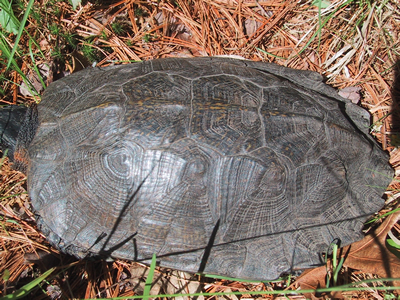Would you think it odd to find a turtle in a flowing stream? If it is a wood turtle (Clemmys insculpta), a stream is the perfect place to be. This fascinating turtle requires freshwater stream habitats, but its home territory will also include the bordering woodlands, meadows and farmlands. The wood turtle’s home range is unusual for a turtle, not only because it is both aquatic and terrestrial, but also because it tends to be linear, following the length of the stream for a mile or more.
Wood turtles are not difficult to identify. A full-grown turtle’s carapace length can reach nine inches, though most found are under eight inches long. The species name insculpta refers to the sculptured appearance of the top shell, or carapace. Each scute on the carapace shows a series of raised ridges (concentric growth rings) that rise like small pyramids. The plastron (bottom shell) is a creamy yellow patterned with irregular black markings along its border, and individuals can be identified by their unique plastron markings. The skin on the wood turtle’s legs and neck is covered in large scales, but it is the strikingly beautiful burnt orange coloring that will take your breath away.
“Ole Redlegs” is an omnivore and eats a variety of foods, including algae, moss, grass, violets, berries, earthworms, slugs, insects, tadpoles, and carrion. It finds these foods in its stream habitat, but also in nearby plowed fields, meadows, and woodlands. The wood turtle is remarkable for its willingness to travel both on land and in the water to find a meal. It is a good climber and, believe it or not, is capable of scaling chain link fencing.
Mating takes place in water in the spring, but the female will lay her eggs in sand or soft soil along gravel beds, roadsides, or meadows. A wood turtle can live for sixty years or more, but will not begin to reproduce until it is at least 14 years old and a female will lay only 4 to 12 eggs per clutch.
In the past this species was collected for human consumption, but now populations suffer mostly from habitat loss and fragmentation. Fragmentation of habitat leads to turtle populations becoming isolated, which leads to increased incidences of road mortality, predation, and collection for pets as they travel in search of mates and suitable nesting sites. Turtles in hay fields are often killed by mowing equipment. Considered imperiled within much of its range, the wood turtle was placed under the protection of the Convention on International Trade in Endangered Species (CITES) in 1992. It is a species of special concern in Connecticut, which protects it under the Connecticut Endangered Species Act. You can help the wood turtle by protecting its streams and adjacent uplands and by leaving it to wander in its natural habitat.
The following is a list from the CT DEEP on what you can do to help turtles:
Leave turtles in the wild. They should never be kept as pets. Whether collected singly or for the pet trade, turtles that are removed from the wild are no longer able to be a reproducing member of a population. Every turtle removed reduces the ability of the population to maintain itself.
Never release a captive turtle into the wild. It probably would not survive, may not be native to the area, and could introduce diseases to wild populations.
Do not disturb turtles nesting in yards or gardens.
As you drive, watch out for turtles crossing the road. Turtles found crossing roads in June and July are often pregnant females and they should be helped on their way and not collected. Without creating a traffic hazard or compromising safety, drivers are encouraged to avoid running over turtles that are crossing roads. Also, still keeping safety precautions in mind, you may elect to pick up turtles from the road and move them onto the side they are headed. Never relocate a turtle to another area that is far from where you found it.
Do not litter. Turtles and other wildlife may accidentally ingest or become entangled in garbage (especially plastic garbage) and die.
Learn more about turtles and their conservation concerns. Spread the word to others on how they can help Connecticut’s turtle populations.
Cindi Kobak



